Blog
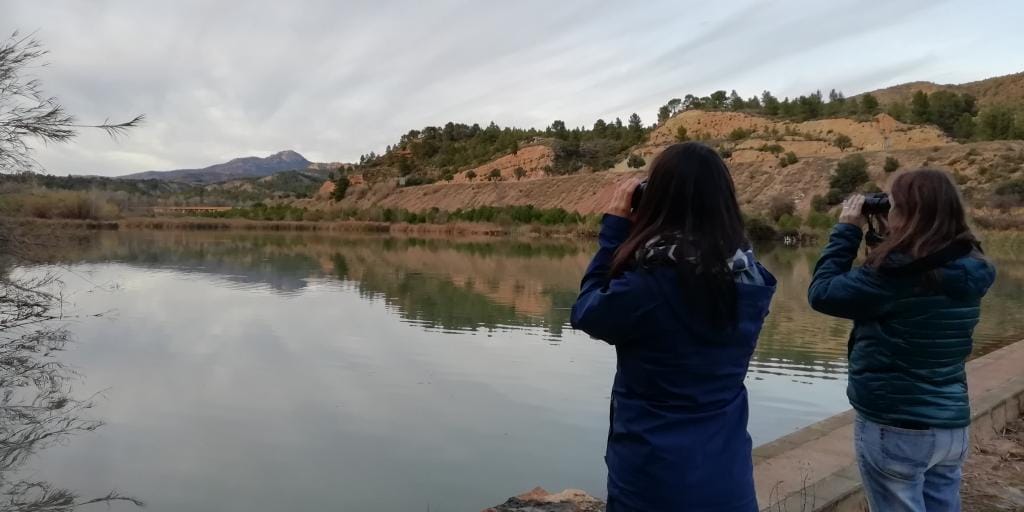
Birding en el Alto Turia
The interior of the province of Valencia holds a surprise for birders and nature lovers. A natural space declared a Biosphere Reserve by UNESCO that includes a wide variety of habitats and landscapes waiting to be discovered.
Today we'd like to propose a birder's journey through the region of the Alto Turia, one of the most rugged areas of the Valencia Region, made up of mountain ranges, valleys, rivers and gorges where you can see some of the most fascinating birdlife in the Mediterranean ecosystems of this part of the Iberian peninsula.
The Birding Comunitat Valenciana website has information and ideas for every level and taste; from beginners to veterans, including those who like to go birding with the family.
One day trips with family or friends, weekends that combine bird watching with a visit to a family-run wine cellar in the valley of Ahillas (Chelva village) and of course made-to-measure excursions for those who want to go deeper into the valleys and explore the most unique corners to find really special species.
Large birds of prey soar over the river Turia and the tributaries that run through this region, such as the griffon vulture, golden eagle and the peregrine falcon and rock-dwelling species that live in the chalky cliffs of gullies and gorges such as the Alpine swift and the red-billed chough.
In winter, you can see species from northern Europe seeking food and refuge in the higher reaches of these mountains coated with juniper thickets. Such species are of great interest to bird lovers and include the ring ouzel, fieldfare, redwing, citril finch and hawfinch.

(Foto: ACTIO Birding)
The region forms part of the province of Valencia and is also home to Bonelli's eagle and the Egyptian vulture, a small migratory vulture whose only breeding place is in the province of Valencia. Both species are real jewels in the crown of Iberian fauna and are included in the Red Book of Spanish birds under the "endangered" category and are also listed as “vulnerable” in the list of wild species under special protection in Spain and the EU.
The cultivated areas of the valleys with their farmhouses and corrals, many of which are abandoned, are ideal habitats for watching the birds who make their home in such areas, such as the European bee eater, Northern wheatear, Western black-eared wheatear and black wheatear, tawny pipit, common whitethroat, as well as the Eurasian skylark, Eurasian jay, corn bunting, and many others.
Some of the best places to see birds and enjoy magnificent landscapes with tremendous natural, historical and cultural value include:
Azud de Tuéjar.
A leisure area located next to the source of the River Tuéjar that used to be a dam that channelled irrigation water for a village.
It was recently converted into a recreational area that houses a micro-reserve for flora with typical riverside plant species such as poplars, white poplars and willows. From here you can see bird species such as the common firecrest, great spotted woodpecker, European crested tit, short-toed treecreeper and many other others that inhabit waterways such as the melodious warbler and the grey wagtail.
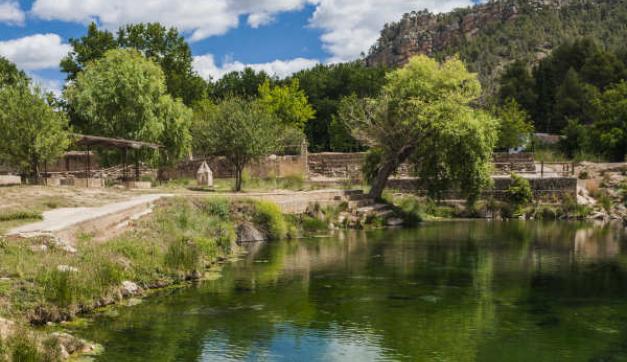
(Foto Turisme Comunitat Valenciana)
The Pico del Remedio, a peak of over 1,000 metres in height, which can be reached from Chelva via a narrow road that goes to Ahillas and La Yesa and which passes through a rugged landscape with spectacular views, rocky areas and pine forests.
It's a natural viewing point for watching birds, with a fantastic view over the Tuéjar valley and the village of Chelva, while above you soar species such as griffon vultures, crows, choughs and the occasional peregrine falcon. A sanctuary with the same name can be found next to the peak; a beautiful spot surrounded by mountains and forests where you can see crossbills, great tits, robins and a multitude of forest birds.
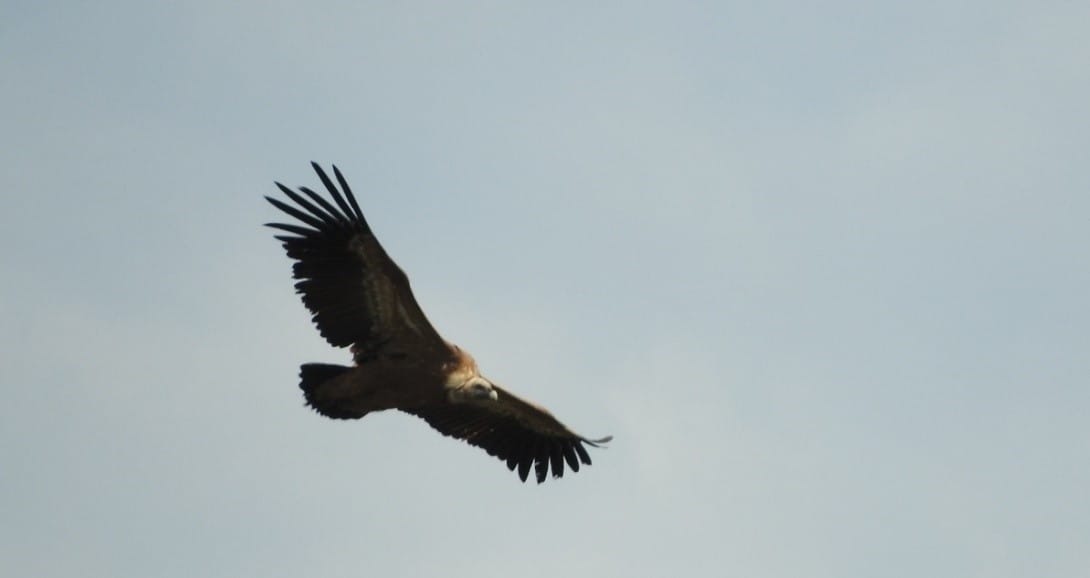
(Foto ACTIO Birding)
From Chelva you can go on the Ruta del Agua, which is a signposted trail that starts and ends in the village centre and that offers you many birding opportunities amongst the vegetation on the banks of the river Tuéjar, where you can try and spot golden orioles or nightingales, or see birds of prey such as the sparrowhawk or the common buzzard. And while you're doing all that you might just come across ancient ruins of water works, flour mills or find a leisure area or lookout point to rest and enjoy the views.
The route of the Peña Cortada, which starts from the nearby village of Calles, takes you to one of the most spectacular areas of the province and the Valencia Region, where you can see an impressive work of Roman engineering, remains of an ancient aqueduct that can be reached via tunnels cut into the rock.
Throughout the route, watch out for the blue rock thrush, or the crag martin while the common kestrels and short-toed eagles can also be seen in this area.
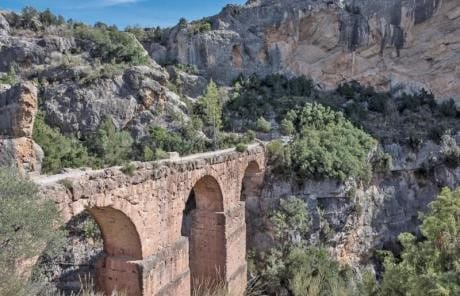
Aqueduct of the Peña Cortada on its way through Calles.
The dam of Benagéber is the starting point of the beautiful Route of the Chorros del Barchel
A truly delightful spot declared a Municipal Natural Park, located between the canyons of the river Túria, in the municipal area of Chelva.
There is a wealth of interesting bird life to be seen all around the area, such as the alpine accentor, as well as other migratory and forest birds that wheel and spin around and amongst the rocks and treetops.
In the meantime, the dam offers the chance to see aquatic birds such as the great crested grebe, which is one of the most abundant species in the area in winter.
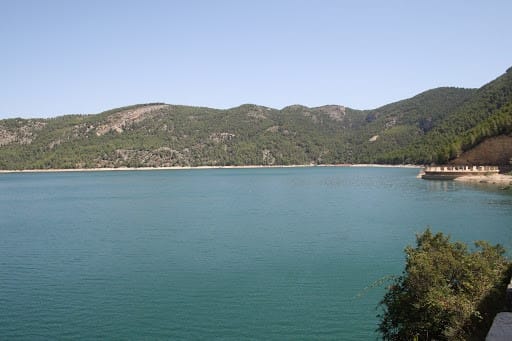
(Foto Turisme Comunitat Valenciana)
The Castle of Domeño is on the top of a ridge next to what was the village of Domeño, which was demolished to make way for the extension of the dam at Loriguilla.
There are panoramic views from where you can see the river Tuejar join the river Blanco, the name given in this region to the river Turia, forming the tail end of the reservoir of Loriguilla.
Here you can see aquatic species such as the grey heron, great cormorant, little grebe and the common sandpiper.
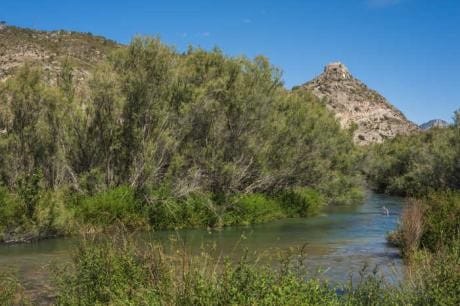
(Foto Turisme Comunitat Valenciana)
This fantastic list ends at the Spot of Los Calderones, in the municipal area of Chulilla.
The Spot of Los Calderones consist of the Gorges (Las Hoces) of the river Turia and nearby peaks at the foot of the dam of the reservoir at Loriguilla. A deep valley of vertical walls that forms a spectacular canyon, regarded as one of the most beautiful spots of the Region of Valencia.
An ideal place to observe cliff-nesting species such as the alpine swift, red-billed chough or the rock sparrow, and protected birds of prey such as Bonelli's eagle or the Eurasian eagle-owl.

(Foto Turisme Comunitat Valenciana)
